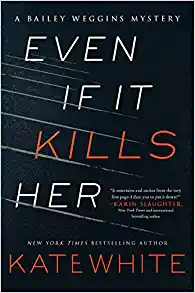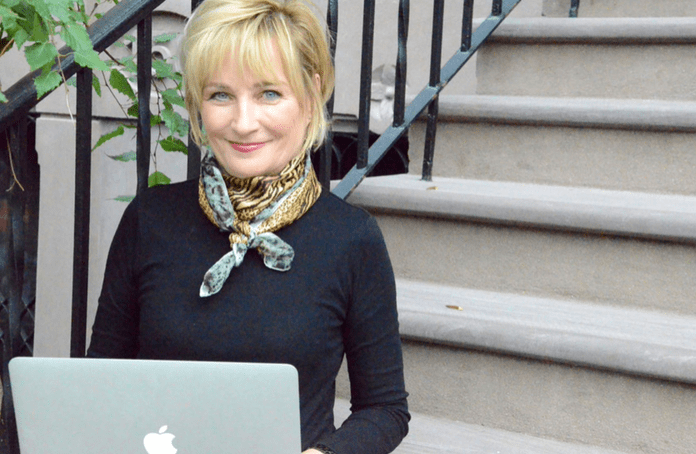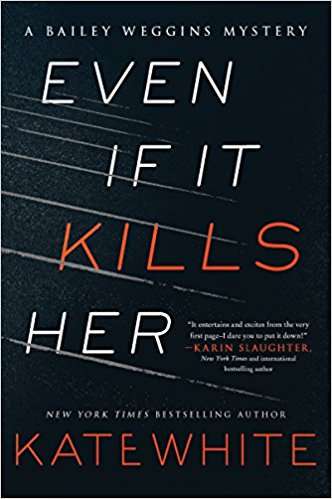Even If It Kills Her by Kate White
What's It About?
Bailey Weggins is not your typical heroine.
She started out as a writer for a major women’s magazine, before becoming an amateur sleuth with a brief moment of work for a celebrity gossip publication, and then turned true crime journalist. But rather than being the tortured lead character who often thinks that the people she loves would be better off without her in their lives, Bailey is actually relatable: sometimes she makes mistakes, but she tries to put them right; she has good relationships, and people she loves. She’s smart, bold, and pretty gutsy – a character that we can not only relate to, but want to read about.
Similarly, the author of the Bailey Weggins Mystery Series, Kate White, is not your typical suspense author. She was the editor-in-chief of Cosmopolitan for fourteen years, has been giving out career advice to women for longer than that, and is probably the nicest person we’ve ever met. In her latest book, Even If It Kills Her, Kate has Bailey take on a case that happened sixteen years ago: the murder of the entire family of Bailey’s college friend, Jillian.
Booktrib was able to catch up with Kate for an interview, where we talked about creating characters that people can relate to, how to write a really good storyline, and being a woman in the business.
Booktrib: You were the editor of Cosmopolitan for 14 years, before you moved into writing full-time; and with the Bailey Weggins series, they’re mystery and crime books. That seems like such a switch to me! Did you find it hard to change to such a completely different genre and style of writing?
KW: Sometimes it still feels so weird to me! I have a book coming out in April – I wrote the book in the 1990s, and I did a completely updated version for the publisher – with advice for women and their work. I speak to a lot of women about their careers, and one of the things I tell them is that it’s important to have a personal brand, even if mine’s gone in a slightly split direction! But I always loved the idea of writing murder mysteries. I mean, before the Internet, when I was trying to pick a career choice, I just wanted to be a writer. I thought, ‘I’ll move to New York City, and write plays and journal articles, and magazine editorials.’ I didn’t know that you kind of had to pick a lane and stay in it. When I won the Glamour Top Ten College Women contest, it really picked a lane for me, and it gave me the chance to work for Glamour. But even during all those years I kept on wanting to write mysteries.
When I was still at Cosmo, I kept writing, kind of as a plan B; now we think of it as a side hustle – but back then, it was more that you might use it one day, and you’ll definitely use it if you get fired. I ended up leaving the magazine business on my own terms, when I wanted to; As much as I loved my job and the magazine world, I wanted to have the freedom that being an author would offer me, and the magazine business was beginning to unravel – I wanted to leave when it was still good, not when it was collapsing. After I left, I was sitting in my office at home, which is no comparison to my office at Cosmo, but I was sitting down, and I saw this red-tail hawk eating a pigeon, and I just sitting there thinking, this is so different.
Booktrib: You have such rich storylines – the twists are always unexpected and unpredictable, and you can never see them coming! Do you plan everything out ahead, or do you start writing, and then have the twists just come to you as things develop?
KW: I definitely plan out ahead of time! I know and respect the authors who are ‘pantsers’ – the ones who fly by the seat of their pants – but for me, I like to plot it out first. I thought that if I don’t know who the killer is, why they’re doing this, their motivations, how they’re doing it, then there was no way I’d be able to lay down the false clues and the misdirection. I actually interviewed a couple of magicians to really perfect the art of misdirection – it’s so much fun to leave red herrings and just a certain number of clues.
For me, I’m the girl who loves notebooks – I always have a notebook. I love the spiral-bound ones you can rip the pages out of. What I’ll do is on the first few pages, I’ll sketch out the overall plan and create diagrams where I’ll plot four or five chapters at a time, and I’ll ask myself little questions to trigger my mind into answering them, to figure out how she’ll find that first clue, or how she’s going to get from A to B. I love sitting in a café with a glass of wine or a cappuccino, watching people, and just planning out the story, and I think that having a notebook really brings that kind of dreamy quality that I wouldn’t be able to get if I just sat down with a laptop.
Booktrib: So in Even If It Kills Her, you start off the beginning of the book having Bailey talk about her regrets in life. I thought this was a really interesting way to start off the book.
KW: I think that in her mid-thirties, Bailey is someone who feels that life has been good to her: she lives in New York City, she has a boyfriend that she loves, she has a lot of gratitude for her life. But we all have these niggling regrets, and I might have drawn on my own experiences of this. I have a lot of friends from across my life: friends from college, friends from when I was traveling – I just reconnected with this woman I met in Patagonia – but I had this one friend in college who I just stopped being in contact with, and I do regret that. She married this guy who was nice, but I always felt a little uncomfortable around him; it wasn’t enough to end the friendship entirely, or to just stop contacting her, but I did. I don’t have a lot of regrets, what I regret that I wasn’t there for my friend, and that feeling was probably something I borrowed on for Bailey. It doesn’t totally fit with Bailey as a person, but it’s there in her relationship with her college friend. The great thing is that when you get older, you put your regrets into perspective.
Booktrib: Just to talk briefly about Bailey and relationships for a moment: you have this balance with Beau, and with Jillian, where Bailey isn’t 100% comfortable with giving all of herself over to these relationships, but at the same time, she’s not really pulling away, or telling herself that everyone is better off without her, which is actually pretty unusual for the heroes of crime and mystery novels. Was this something you found hard to write in a character?
KW: I think it started with me wanting to write a character who wasn’t significantly tortured or troubled. One of the things I found refreshing, writing this book, is that as much as I love psychological thrillers, I’m kind of sick right now of the tortured female character. I wanted to write someone who just seemed a little more like the women I know: things can throw their lives in a tizzy at times, but it’s not to the degree that you find in a lot of these books. I wanted to write someone who is just really sure of herself, and has an interesting life, and good friends, but as I started to write her [Bailey], I made her have this hand-grenade of a short marriage. I found that as a person, she was gun-shy about further commitment; she’s not tortured by it, but it’s created this huge problem in her life. She’s in love, she wants to be in love, but there’s just this one thing in her past that’s still holding her back. So in some ways, she just took on a life of her own. Part of me just feels like there are women that, even if they don’t read the mystery or thriller series, they’ll pick up the book because they want to read a character that’s more realistic to them. There are certain things in Bailey’s life that have happened to her, but haven’t shaped her in a totally negative way.
Booktrib: One of the things that’s really made clear in Even If It Kills Her, and the Bailey Weggins series as a whole, is that you’re so good at writing not only strong female characters, but well-rounded, really three-dimensional characters. We all talk about trying to get more realistic roles for women in film, or encourage people to write better parts for women, but that doesn’t mean that it’s happening. When you’re writing characters that are so complex and interesting, is this something that you take into consideration?
KW: I remember once, it was a number of books ago – I was actually looking at online reviews; I try not to look too often, but I remember seeing a review for one of my favorite authors, Sue Miller, and when I saw that she had one star reviews, I just said, “hey, if she can have a one star review, and still be as good as she is, so can I” – but a review for one of my books said that the characters were like cardboard! It made me think about the fact that I was so interested and invested in the twists, the plot, and being able to surprise the reader, but that I didn’t want to do that at the expense of creating characters.
I know Bailey is a great character – someone actually wrote to me and told me that they named their kid Bailey! – but that comment really forced me to make sure that when I start writing, I’ve really thought every character out; and if there is someone who’s not as developed, I try to do extra work. I’ll go online and try to find someone in a picture or an image, or in a hotel lobby or restaurant, who could be that person. I’m a very visual person, so I have to get the physical aspects first, and often if I don’t have that to create the character, it just won’t come.
It’s actually a funny story: there was one day I saw a guy in a news-story online, and I thought, oh my god, that is exactly who I need to work with to create this new character and now I think that guy’s planning on running for President in the next four or eight years. So I hope he doesn’t pick up a copy of the book and recognize himself!
Booktrib: Speaking of bold women, as the editor of Cosmopolitan, a major magazine publication, I imagine that you faced some adversity as a woman in the business.
KW: The great thing about working for companies like a women’s magazine, at least in my experience, is that the guys in charge, and the guys I met were so awesome, and really evolved. I worked for a number of years for Chuck Townsend, who became the CEO of Condé Nast, and he just really appreciated strong women who spoke their minds. I also got to work with Cathie Black, who ran the magazine position at Hearst. It’s great to work for powerful women because you get to learn so much from them. I was really fortunate; most of the guys I worked for were really terrific. There’s a guy called Michael Golden who I worked for, and I just remember telling him “I have to go home, my kids have lice, I have to do the thing with the shampoo!” and it was just like, “I work for a guy who I can say this to.”
At the same time, I mean, I was exposed for a number of jerks over the years – I once had a guy who was an executive at a company who jumped me in a cab! I had to literally wrestle this guy away from me, and reflecting on the Harvey Weinstein stuff – you’re always on some unconscious level, being careful, and making sure that you’re on course. I have five brothers, so I’ve always been comfortable making friends with guys, but it’s like you have to double check to make sure that you’re not sending out the wrong signals, or “does that mean something.” It’s just such a draining mindset to be in all the time.
Booktrib: And finally, do you have any advice for aspiring writers, or writers who are just starting out?
KW: I would say that the basic things that I’ve always heard, that everyone always hears, they really do work. They say that when you have something bad happen, it’s best to stay busy, and it seems like such a cliché, but it really works. But I would certainly say not only reading, but paying attention to what the author has really done to keep you turning those pages, or reading that book until 3AM; even take notes in the margins. For me, re-reading the Nancy Drew books was really good for writing cliffhanger endings. Those books really have a ton of good stuff.
I also found it helpful to read a lot of screenplay writing books. They talk about structure and where things need to kick in. A lot of beginning writers have a good sense of character, but the overall storyline can get kind of saggy, so reading the seven pillars of screenwriting, or screenplay writing books really helps.
And then just being an observer: watching the way people interact with each other, and listening to how they talk to each other. Someone told me the other day that even watching a video with the sound off, you begin to see the body language people use when they interact. If you try to capture that, it won’t be so cliché as “he furrowed his brow.”
Even If It Kills Her: A Bailey Weggins Mystery will be published on October 31st. Be sure to watch out for our giveaway of the book this Thursday!
For more information on the author, please visit her website at katewhite.com. Be sure to check out her Facebook page, twitter, or Instagram.
Buy this Book!
Amazon





